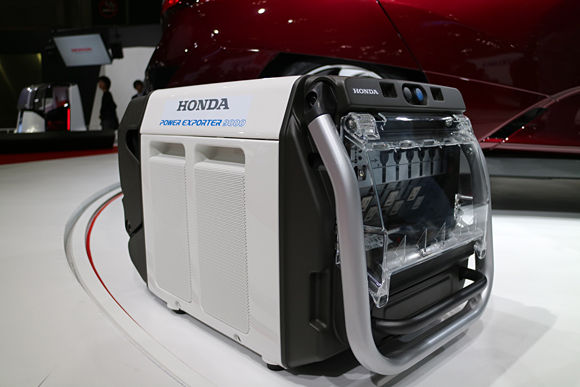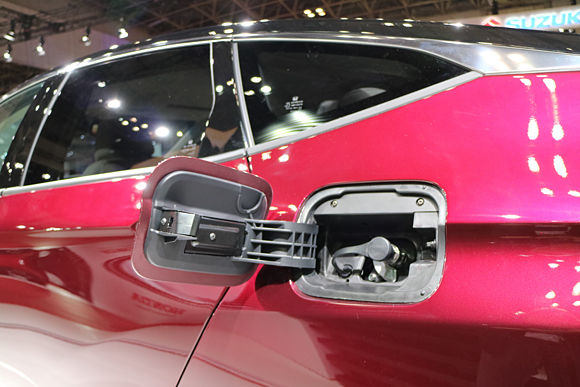At the 2015 Tokyo Auto Show, Honda showed the Clarity Fuel Cell car that’s planned for production and lease-only deliveries starting in March 2016. According to Honda, the new Clarity FCV gives all the convenience of existing gasoline cars but it’s a fuel cell vehicle and therefore has zero tail-pipe emissions. This was made possible by a fuel cell drive-train that’s more compact, as in delivering more power in a smaller unit of space and volume. Click here for the press release.
By using technology developed by Honda, the fuel cell stack is “downsized by 33%” from previous Honda fuel cell stacks, while increasing power output to 100 kiloWatts and power output density of 3.1kW/L. Another way to measure the size is that, according to Honda, the fuel cell stack is similarly sized to a 6 cylinder gas engine, and fits completely within the “engine” compartment. That in turn makes it possible to fit the Honda fuel cell system into their existing model line.
An advantage named by Honda is a passenger cabin that seats five adults comfortably.
The 70MPa high-pressure hydrogen storage tank gives a 700 kilometer (434 mile) cruising range – according to Honda. That number came from Honda’s own testing, in JC08 mode and after refueling the vehicle at a hydrogen station with charging pressure of 70 MPa which comply with SAE standards (J2601). The press release says “cruising range may vary when the vehicle is refueled at hydrogen station with different specifications, as amount of hydrogen put in the tank will vary depending on the specifications of hydrogen station.” In other words, your mileage may vary not just due to your driving style but the characteristics of the fueling station. The fueling time is about 3 minutes at a 70 MPa station, but again may vary depending on the hydrogen pressure at a given fueling station.
An associated product is the Power Exporter 9000. This connects to a CHAdeMO port on the car, and exports power to a house. With this unit the Clarity Fuel Cell car can power a typical home for 7 days. Honda says the product will eventually be made available in the U.S. and Europe.
Plans are to only offer leases of the Clarity Fuel Cell car only, and to focus on local government and business customers. In other words we can expect regular folk to have a very hard time getting their hands on one. The price will be 7.66 million yen, or about $63,000 USD at today’s exchange rate.
The production volume will be miniscule — Honda uses this phrase: “small-volume production.” This has been the case with other fuel cell vehicles from other automakers. Apparently the goal is to produce only enough vehicles to qualify for enough clean vehicle credits to keep government regulators happy.
Analysis
Can you say “Compliance Car”?
Honda is patting themselves on the back with this car for having begun work on fuel cell vehicles back in 2002. The problem is that production volumes are still miniscule for FCV’s, while the battery EV world is taking off in a big way. Well, you might say I was just blowing hype with that statement, but the growth rate for BEV sales is steep. All the signs exist that BEV’s will shortly become attractive to regular people because they’ll deliver 200+ miles range in an affordable package, rapidly growing charging infrastructure that can expand at lower cost than hydrogen fueling infrastructure, and with a fuel cost that’s a fraction of gasoline cost.
In other words, Fuel Cell vehicles are interesting, but they’ll have a very hard time catching up to battery electric vehicles. By the time FCV’s get out of the starting gate, battery electric vehicles will have established themselves.
The Power Exporter 9000 is an interesting companion product. But, I don’t grok why it will be of much interest to customers. We hardly suffer power outages, making the whole “your car powers your house” concept not much more than a passing interest. Further, powering your house from your fuel cell car extracts some of the hydrogen, reducing the remaining driving range. With a battery EV, it’s easy to replace the power used to run your house by simply recharging the car when the power comes back on. With a fuel cell vehicle, one cannot recharge the hydrogen tank at home, meaning you must trek over to the hydrogen refueling station.
- The USA should delete Musk from power, Instead of deleting whole agencies as he demands - February 14, 2025
- Elon Musk, fiduciary duties, his six companies PLUS his political activities - February 10, 2025
- Is there enough Grid Capacity for Hydrogen Fuel Cell or Battery Electric cars? - April 23, 2023
- Is Tesla finagling to grab federal NEVI dollars for Supercharger network? - November 15, 2022
- Tesla announces the North American Charging Standard charging connector - November 11, 2022
- Lightning Motorcycles adopts Silicon battery, 5 minute charge time gives 135 miles range - November 9, 2022
- Tesla Autopilot under US Dept of Transportation scrutiny - June 13, 2022
- Spectacular CNG bus fire misrepresented as EV bus fire - April 21, 2022
- Moldova, Ukraine, Georgia, Russia, and the European Energy Crisis - December 21, 2021
- Li-Bridge leading the USA across lithium battery chasm - October 29, 2021























Perhaps,… just perhaps, Honda’s ChaDeMo ‘exporter will turn into an input port for this car to make it into a plug-in hybrid. All of the ‘fuel cell’ cars use a small traction battery alongside to handle acceleration and hill climbing that the fuel cell output would choke on. This compromise with the “Energy” corporations in mind is a last gasp effort to maintain a business model where fuel is bought at retail stations in the public mind. Both station/ distributor real estate losses, and perhaps more cogently its mandated hazardous waste site clean-up costs will keep them trying to wring more profits for as long as possible. I recall the switch-over in New England from Coal fired home heating oil from newly laid pipelines. The coal companies tried everything they knew to discourage the public from converting to the relatively cleaner, easier to use fuel. Now its the oil companies turn.